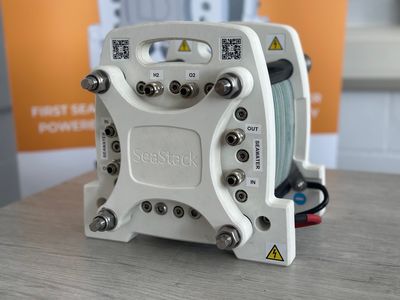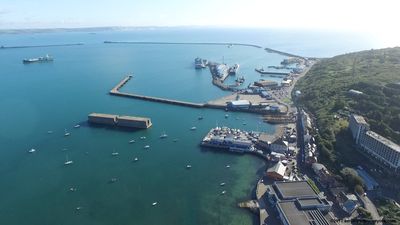Latent Drive Wins £630k from Innovate UK for HydroPort Direct Seawater Hydrogen Project
Published:
Read Time: 6 mins
Latent Drive Wins £630k from Innovate UK for HydroPort Direct Seawater Hydrogen Project
south coast trials coincide with ERM report, 2GW offshore wind plans and £2.25m fundraise
· Offers pathway for offshore green hydrogen, direct from seawater, for less than $2/kg
· Eliminating desalination and water treatment halves footprint, costs and maintenance burden for producing hydrogen in offshore wind and other space-constrained locations
· Avoids expensive and rare platinum group metals from increasingly unsustainable sources
· Market potential validated by independent report from leading sustainability advisor, ERM
· Trials hosted by Portland Port on the Dorset Coast in southern England
17 March 2025: Latent Drive, developer of ground-breaking technologies to produce abundant and affordable green hydrogen at source, has won a £630,000 grant under Innovate UK’s Launchpad South West Marine and Maritime competition. This will fund a demonstration trial to fuel a harbour patrol vessel with green hydrogen, produced directly from seawater and renewable energy using Latent Drive’s SeaStack technology.
The HydroPort trials are led by Latent Drive, supported by Dorset Council and hosted by Portland Port, in collaboration with Logan Energy, SALINE Business Services and the University of Exeter’s Centre for Future Clean Mobility. They will assess the market potential for SeaStack in decarbonising ports – especially as operators respond to government targets and public demand for evermore offshore renewables.
SeaStack is the world’s first commercial direct seawater-to-hydrogen electrolyser stack, optimised for installation offshore. It has a wide operating range to capture more wind energy at low cost, and is designed to produce green hydrogen direct from seawater for less than $2/kg. SeaStack is designed for use on harbour walls, offshore wind turbines, and floating platforms to make best use of energy supplies and refuelling sites.
The Dorset coast has huge potential to become a leading renewables super cluster, with a growing pipeline of planned projects. This includes the 10th February PortWind agreement with IKEA-backed renewables developer, Source Galileo, for up to 2 gigawatts of offshore wind capacity – enough to power around 3 million UK homes. The area also offers significant hydrogen storage capacity in underground salt caverns, on a sufficient scale for refuelling trans-atlantic shipping. To reach net zero by 2050 it is estimated that 60 million tonnes of green hydrogen will be required annually for marine fuels[1].
Frazer Ely, CEO and Founder of Latent Drive said: “Huge thanks to our own team, and the wider HydroPort consortium, for beating tough competition to win this substantial grant from Innovate UK. We are grateful for this ongoing government support which will help to demonstrate how our SeaStack electrolyser can revolutionise clean hydrogen production, location and economics – without expensive desalination or rare metals – in a global market projected to be worth $642 billion by 2030[2].”
ERM, the world’s largest advisory firm focused solely on sustainability, recently issued an independent report analysing the overall hydrogen market, green hydrogen from wind and resulting opportunities for SeaStack. Based on low and high hydrogen adoption scenarios in the UK and Europe, the report outlines SeaStack’s competitive advantages, positions it as a solution to increasing grid congestion and water stress, and explores optimal routes-to-market.
According to ERM, the UK is expected to deploy up to 9GW of offshore wind powered electrolyser capacity by 2040. That’s from a current baseline of zero, with 2.4GW of electrolyser projects announced up to 2030, and 6.3GW announced up to 2040. Meanwhile Europe is expected to deploy up to 90GW of offshore wind powered electrolyser capacity by 2040.
ERM’s report emphasises, in particular:
· SeaStack’s potential to eliminate desalination and water treatment plant, compared to conventional electrolysis technologies;
· The resulting cost and footprint reductions – especially valuable in offshore and other space-constrained applications;
· Further potential cost savings due to the use of electrodes free from platinum group metals;
· SeaStack’s fast, dynamic response capability – ideal for direct connection to renewables;
· The high purity of SeaStack’s hydrogen output;
· Potential priority markets – including off / near-shore renewables, refineries, grid blending and power generation.
Tom Haughton, Partner at ERM and report co-author, commented: “The incorporation of electrolysers into offshore wind energy plants is increasingly beneficial for offshore wind farms far from shore, where electrical cable connection to land becomes progressively more uneconomic. Direct seawater electrolysis could potentially improve the overall system efficiency and reduce costs as the technology matures.”
ERM also highlighted the sustainability significance of being able to process non-freshwater sources – given that over 35% of the operational and planned hydrogen production capacity is in water-stressed regions.
Frazer continued: “It’s encouraging that, at the same time as we demonstrate hydrogen use in a port environment, renowned sustainability advisors ERM have qualified the SeaStack concept, compared the cost benefits and identified global market potential in hundreds of gigawatts and millions of tonnes of hydrogen.”
This latest funding follows a range of previous government-backed grants totalling £1.1m, including a share of £500k from the Net Zero Technology Centre in October 2024. Latent Drive has also just launched a £2.25 million investment round, including a £250k Seed Enterprise Investment Scheme allowance.
Darren Gee, Programme Manager at the Net Zero Technology Centre concluded: “Electrolyser technology is an exciting sector right now, and the technological breakthroughs of today will pave the way for the green energy solutions of tomorrow. Together with key industry partners, we have identified Latent Drive’s SeaStack as a groundbreaking technology in this space – scalable and with the potential to significantly push the boundaries of hydrogen production.”
[1] International Renewable Energy Agency (IRENA): World Energy Transitions Outlook
[2] Deloitte: Green hydrogen – Energizing the path to net zero
Ends
Editors notes
Contacts
For media enquiries, imagery, or to arrange a briefing, please contact:
Susan Brownlow or Justin Heath
Resonates
+44 1635 898698
Commercial enquiries:
Anna Studley
Latent Drive
+44 1305 896968
About Latent Drive
Based on the former Winfrith nuclear site on southwest England’s Jurassic coast, and supported by government and private funding, Latent Drive is developing cutting-edge electrolyser technologies to replace fossil fuels – with a mission to make green hydrogen abundant and affordable. This is essential to decarbonise industry, provide energy storage and secure energy supplies.
Latent Drive has developed SeaStack, enabling green hydrogen production at the source of energy. SeaStack is the world’s first commercial direct seawater-to-hydrogen electrolyser stack, optimised for installation offshore. With a wide operating range, it is able to capture more renewable energy at lower cost and can produce green hydrogen directly from seawater for less than $2/kg.
A key component of SeaStack is Latent Drive’s innovative Catrodes. These superior catalysed electrodes do not contain rare and expensive platinum group metals (PGMs), as required in conventional electrolysers. Latent Drive uses ordinary stainless-steel to make Catrodes, which combine both catalyst and electrode as one homogeneous part, without additional ingredients. Furthermore, Catrodes aren’t just a laboratory concept, they are commercially available via an established distributor network – with hundreds already supplied worldwide.
About Innovate UK
Innovate UK, part of UK Research and Innovation, is the UK’s innovation agency. Our mission is to help companies to grow through their development and commercialisation of new products, processes and services, supported by an outstanding innovation ecosystem that is agile, inclusive and easy to navigate. The Launchpad programme supports the UK government’s goals in its Levelling Up white paper, with the South West Marine and Maritime competition funding projects across Cornwall and Isles of Scilly, Devon, Somerset and Dorset. These projects will contribute to the Great South West’s ambitions for net zero targets, while strengthening key regional strategic marine and maritime markets.



